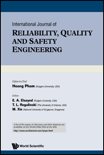
International Journal of Reliability Quality and Safety Engineering
Scope & Guideline
Unveiling Insights for Safer, More Reliable Systems
Introduction
Aims and Scopes
- Reliability Engineering:
The journal emphasizes the development and application of reliability engineering principles, including modeling, assessment, and optimization of systems to ensure their functionality and performance over time. - Quality Control and Improvement:
Research focusing on quality control methodologies, statistical process control, and quality improvement techniques is a core area, aiming to enhance product and service quality in various industries. - Safety Engineering:
The journal covers safety engineering topics, including risk assessment, safety management systems, and safety-related software, to promote safe operational practices in engineering. - Statistical Modeling and Data Analysis:
A significant focus is placed on statistical methods for reliability and quality analysis, including Bayesian methods, machine learning, and advanced statistical techniques for analyzing complex data. - Maintenance Strategies:
The journal explores innovative maintenance strategies and policies, emphasizing preventive and predictive maintenance approaches to enhance system reliability and reduce downtime. - Software Reliability:
Research on software reliability, including software reliability growth models and testing strategies, is a vital aspect, reflecting the growing importance of software systems in engineering.
Trending and Emerging
- Machine Learning and AI in Reliability:
There is a significant increase in research exploring the application of machine learning and artificial intelligence techniques in reliability and quality engineering, indicating a shift towards data-driven approaches. - Integrated Maintenance Strategies:
Emerging themes focus on integrated maintenance strategies that combine predictive maintenance, condition monitoring, and real-time analytics to optimize system performance and reliability. - Complex Systems Reliability:
Research on the reliability of complex systems, such as networked and distributed systems, is gaining traction, reflecting the need to address the challenges posed by interconnected engineering systems. - Software Reliability and Testing Innovations:
The journal is increasingly publishing papers on innovative software reliability testing and assessment methods, emphasizing the importance of software performance in overall system reliability. - Risk Assessment with Advanced Analytics:
The application of advanced analytics and decision-making frameworks in risk assessment is trending, showcasing a move towards more sophisticated and data-informed safety management practices.
Declining or Waning
- Traditional Reliability Models:
While traditional reliability models have been foundational, there appears to be a decline in novel contributions to this area, as more researchers focus on integrating advanced computational methods and machine learning into reliability studies. - Deterministic Quality Control Approaches:
Research centered around deterministic quality control techniques seems to be diminishing as industry trends shift towards more flexible, adaptive, and data-driven quality improvement methodologies. - Static Risk Assessment Models:
Static models for risk assessment are becoming less prominent as dynamic and real-time risk management approaches gain traction, reflecting the need for more responsive safety engineering solutions. - Single-Factor Maintenance Policies:
Research focusing on single-factor maintenance policies is waning, with a noticeable shift towards multi-objective and integrated maintenance strategies that consider various system parameters and uncertainties.
Similar Journals

STRUCTURAL SAFETY
Connecting scholars for a safer built environment.STRUCTURAL SAFETY is a premier journal dedicated to advancing the field of engineering with a focus on safety, risk, reliability, and quality in structural analysis and design. Published by Elsevier, this esteemed journal boasts an impressive Impact Factor and ranks in the top quartiles (Q1) of key categories including Building and Construction, Civil and Structural Engineering, and Safety, Risk, Reliability, and Quality. With a significant history spanning from 1982 to 2024, STRUCTURAL SAFETY fosters scholarly exchange among researchers, professionals, and students by publishing innovative and high-quality research articles that contribute to the safety and resilience of engineered structures. The journal operates without open access barriers, ensuring a broad audience can access invaluable insights in the engineering realm. Its distinguished Scopus rankings further underscore its impactful role within the academic community, making it an essential resource for anyone invested in the discipline of structural safety.
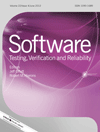
SOFTWARE TESTING VERIFICATION & RELIABILITY
Navigating the Landscape of Software Verification and ReliabilitySOFTWARE TESTING VERIFICATION & RELIABILITY, published by Wiley, serves as a premier journal in the fields of software engineering, risk management, and quality assurance. With an ISSN of 0960-0833 and E-ISSN 1099-1689, this journal has been a pivotal resource since its inception in 1991, providing insights into the latest methodologies and technologies related to software testing and verification through to 2024. The journal is recognized for its rigorous peer-review process and boasts an impressive reputation, rated Q2 in Media Technology and Safety, Risk, Reliability and Quality, along with a Q3 rank in Software as of 2023. Its Scopus ranks further solidify its standing within the academic community, placing it in the 62nd and 43rd percentiles for Engineering and Computer Science, respectively. The journal fosters a collaborative environment for researchers, professionals, and students, encouraging the exploration of cutting-edge research, applications, and innovations in software testing and reliability, making it an invaluable asset for those seeking to advance their knowledge and expertise in this essential area.

International Journal of System Assurance Engineering and Management
Fostering Knowledge for a Safer, More Reliable FutureThe International Journal of System Assurance Engineering and Management, endorsed by SPRINGER INDIA, stands as a pivotal platform in the field of Safety, Risk, Reliability, Quality, Strategy, and Management. Established in 2010, this peer-reviewed journal offers a rich repository of innovative research and practical insights that address contemporary challenges in system assurance across various sectors. With a commendable Q2 category ranking in both Safety, Risk, Reliability, and Quality, as well as in Strategy and Management for 2023, the journal is recognized for its rigorous standards and significant contribution to the academic community. Although it operates under a subscription model, the journal ensures wide dissemination of critical findings to its readership, which includes researchers, industry professionals, and students. With its Scopus rankings affirming its impact—ranked #71/207 in Safety, Risk, Reliability and Quality, and #198/478 in Strategy and Management—the journal is a must-read for those seeking to enhance their knowledge and application of engineering and management principles in real-world settings.

Journal of Statistical Theory and Applications
Fostering collaboration and knowledge sharing in statistical sciences.Journal of Statistical Theory and Applications is a prominent open-access journal published by SPRINGERNATURE, dedicated to advancing the fields of statistics, applied mathematics, and computer science. Operating since 2013, this journal serves as a vital platform for researchers to disseminate their findings and contributes significantly to the global discourse in statistical theory and its practical applications. With an impressive Q3 quartile ranking in 2023 across multiple categories including Applied Mathematics and Statistics, the journal showcases quality research, and its Scopus rankings position it favorably within its fields, reflecting its growing influence and accessibility. The journal emphasizes the importance of making research freely available, adhering to open access principles, which facilitates knowledge sharing among academics, practitioners, and students worldwide. By fostering innovative statistical methodologies and applications, the Journal of Statistical Theory and Applications plays a crucial role in shaping contemporary statistical practice and education.
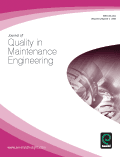
Journal of Quality in Maintenance Engineering
Elevating Standards in Industrial EngineeringJournal of Quality in Maintenance Engineering, published by EMERALD GROUP PUBLISHING LTD, is a leading academic journal in the fields of Industrial and Manufacturing Engineering, Safety, Risk, Reliability and Quality, and Strategy and Management. With an ISSN of 1355-2511 and an E-ISSN of 1758-7832, this quarterly publication has been a vital resource for professionals and researchers alike since its inception in 1995. As of 2023, the journal has achieved a commendable Q2 ranking across multiple categories, showcasing its robust influence in advancing knowledge and practices in maintenance engineering. Although not an open-access journal, it offers various access options to facilitate research dissemination. With a focus on quality improvement and sustainable practices in maintenance strategies, the journal seeks to bridge the gap between theoretical research and real-world applications, making it an essential read for anyone invested in enhancing maintenance engineering practices.
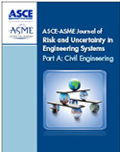
ASCE-ASME Journal of Risk and Uncertainty in Engineering Systems Part A-Civil Engineering
Championing Safety and Sustainability in Infrastructure.ASCE-ASME Journal of Risk and Uncertainty in Engineering Systems Part A-Civil Engineering, published by the American Society of Civil Engineers (ASCE), is a leading journal dedicated to advancing the understanding and application of risk and uncertainty in civil engineering systems. With an ISSN of 2376-7642, this journal has been a pivotal platform for researchers and practitioners since its inception in 2015, converging its rigorous exploration through to 2024. It holds a commendable position in the academic community, securing a Q2 rating in categories such as Building and Construction, Civil and Structural Engineering, and Safety, Risk, Reliability and Quality as of 2023. The journal aims to disseminate innovative research that tackles the critical challenges posed by uncertainty in engineering systems, thus promoting safety, sustainability, and reliability in infrastructure. With impressive Scopus rankings, including a 76th percentile in Building and Construction, it continues to attract high-quality contributions from scholars worldwide. Emphasizing open dialogue, the journal does not currently adopt an open access model but remains committed to providing essential insights for the enhancement of civil engineering practices. Researchers, professionals, and students alike will find invaluable resources to enhance their knowledge and practice in this dynamic field.

Proceedings of the Institution of Mechanical Engineers Part O-Journal of Risk and Reliability
Fostering a Culture of Safety through Scholarly Discourse.Proceedings of the Institution of Mechanical Engineers Part O – Journal of Risk and Reliability is a highly regarded journal published by SAGE Publications Ltd, specializing in the critical fields of Safety, Risk, Reliability, and Quality. Established in 2006 and extending its coverage until 2024, this journal serves as a vital platform for researchers and professionals to disseminate innovative findings and discuss emerging trends and methodologies related to risk assessment and reliability engineering. With an impact factor that places it in the Q2 quartile of its category and ranked 69th out of 207 in Scopus, it has garnered significant attention within the academic community, ensuring robust visibility and influence. Readers can expect rigorous peer-reviewed articles that contribute to advancing knowledge and practices in the field, fostering a deeper understanding of the complexities and integral practices essential for safety and reliability. As a leading publication within the United Kingdom, it continues to play an instrumental role in shaping contemporary discussions and research in this vital sector.

QUALITY AND RELIABILITY ENGINEERING INTERNATIONAL
Transforming Challenges into Reliable SolutionsQUALITY AND RELIABILITY ENGINEERING INTERNATIONAL is a prestigious journal published by WILEY, dedicated to advancing the fields of quality, reliability, and engineering. With an ISSN of 0748-8017 and an E-ISSN of 1099-1638, this journal provides a platform for scholarly articles that delve into the intricacies of management science, operations research, safety, risk, reliability, and quality, as evidenced by its strong ranking in the Q2 category for both Management Science and Operations Research, as well as Safety, Risk, Reliability, and Quality. Established in 1985 and continuing through 2024, the journal has garnered a solid reputation in the academic community, achieving a Scopus ranking in the 70th and 64th percentiles for its respective categories. Although it does not offer open access, its authoritative content is essential for researchers, professionals, and students seeking to deepen their understanding of quality and reliability principles. With its UK-based publishing address ensuring global reach, this journal remains at the forefront of discussions surrounding engineering quality and reliability methodologies.
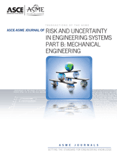
ASCE-ASME Journal of Risk and Uncertainty in Engineering Systems Part B-Mechanical Engineering
Empowering Engineers with Insights on UncertaintyASCE-ASME Journal of Risk and Uncertainty in Engineering Systems Part B-Mechanical Engineering, published by the reputable ASME, is a leading platform dedicated to advancing knowledge in the field of mechanical engineering with a particular emphasis on risk assessment and uncertainty analysis. With an ISSN of 2332-9017 and an E-ISSN of 2332-9025, this journal has established itself as a significant contributor to ongoing research in safety, risk, and reliability, consistently ranking in the Q2 quartile for Mechanical Engineering as well as Safety Research categories. As evidenced by its impressive Scopus rankings—including a notable 80th percentile in Safety Research—this journal fosters high-quality research that informs engineering practices and enhances safety protocols. Operating under a traditional access model, it aims to provide researchers, professionals, and students with essential insights and methodologies to address contemporary challenges in engineering systems. Each contribution reflects an aim to bridge theory and application, thus making the journal an invaluable resource for stakeholders striving for excellence in mechanical engineering and safety management.

Journal of Failure Analysis and Prevention
Pioneering Research in Materials and Mechanical IntegrityJournal of Failure Analysis and Prevention, published by SpringerNature, stands as a vital resource in the fields of Materials Science, Mechanical Engineering, and Safety, Risk, Reliability and Quality. With an ISSN of 1547-7029 and an E-ISSN of 1864-1245, this journal has been dedicated to advancing the understanding of failure mechanisms and prevention strategies since its inception in 2001. Its convergence of rigorous research from various domains underscores its importance, achieving a Q3 classification across multiple engineering categories as of 2023. As of the latest rankings, it holds significant positions, including #114 in Safety, Risk, Reliability and Quality and #408 in Mechanical Engineering, illustrating its role in fostering scholarly dialogue and innovation. Although it does not currently offer open-access options, the journal endeavors to be accessible for researchers and professionals seeking impactful, high-quality analyses that inform both safety practices and engineering improvements. Whether you are a researcher pushing the boundaries of knowledge or a professional applying these principles, the Journal of Failure Analysis and Prevention is an indispensable part of your academic toolkit.